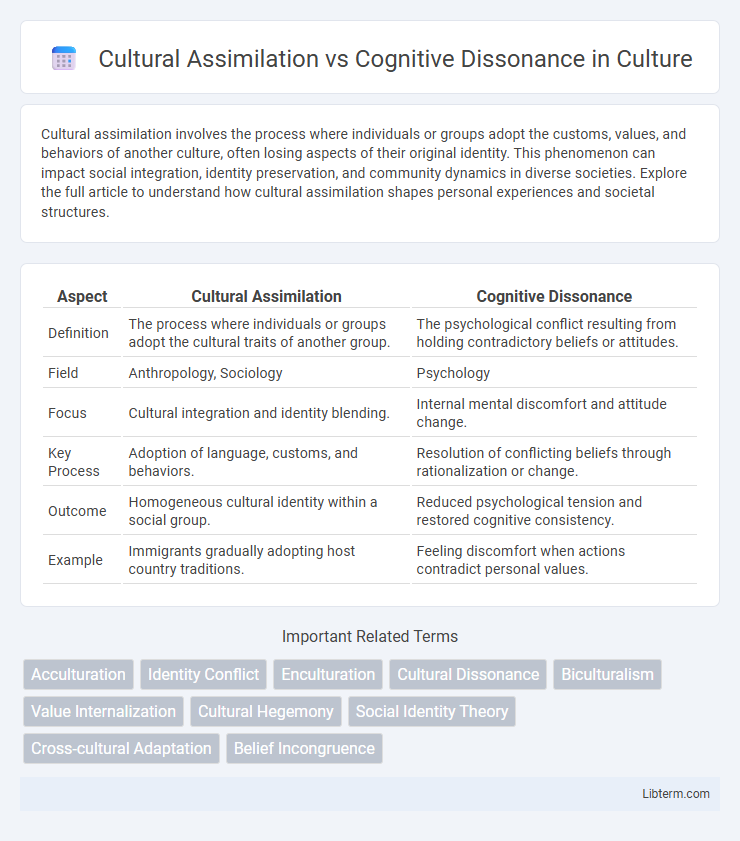Cultural assimilation involves the process where individuals or groups adopt the customs, values, and behaviors of another culture, often losing aspects of their original identity. This phenomenon can impact social integration, identity preservation, and community dynamics in diverse societies. Explore the full article to understand how cultural assimilation shapes personal experiences and societal structures.
Table of Comparison
| Aspect | Cultural Assimilation | Cognitive Dissonance |
|---|---|---|
| Definition | The process where individuals or groups adopt the cultural traits of another group. | The psychological conflict resulting from holding contradictory beliefs or attitudes. |
| Field | Anthropology, Sociology | Psychology |
| Focus | Cultural integration and identity blending. | Internal mental discomfort and attitude change. |
| Key Process | Adoption of language, customs, and behaviors. | Resolution of conflicting beliefs through rationalization or change. |
| Outcome | Homogeneous cultural identity within a social group. | Reduced psychological tension and restored cognitive consistency. |
| Example | Immigrants gradually adopting host country traditions. | Feeling discomfort when actions contradict personal values. |
Understanding Cultural Assimilation
Cultural assimilation involves the process by which individuals or groups adopt the cultural traits of another group, often leading to the loss of original cultural identity. This process can be voluntary or imposed and typically affects language, behaviors, values, and social norms. Understanding cultural assimilation is crucial in examining how minority groups integrate into dominant societies while navigating identity transformation and social acceptance.
Defining Cognitive Dissonance
Cognitive dissonance refers to the psychological discomfort experienced when an individual holds two or more conflicting beliefs, values, or attitudes simultaneously. This mental tension often compels a person to alter their beliefs or behaviors to achieve internal consistency and reduce discomfort. Unlike cultural assimilation, which involves adopting the traits of another culture, cognitive dissonance centers on the internal struggle to reconcile contradictory cognitions within one's own mind.
Historical Perspectives on Assimilation
Historical perspectives on cultural assimilation reveal the gradual integration of minority groups into dominant societies, often driven by policies aimed at social cohesion and national identity formation. Governments in various eras implemented assimilation strategies such as language suppression, education reforms, and cultural rituals to minimize ethnic distinctions and promote uniformity. Cognitive dissonance frequently emerged among assimilated individuals, as conflicting beliefs between their heritage and imposed identities generated psychological stress, influencing both individual behavior and community dynamics.
Psychological Foundations of Dissonance
Cognitive dissonance arises when individuals experience conflicting beliefs or behaviors, creating psychological discomfort that motivates efforts to restore internal consistency. The psychological foundation of dissonance theory, developed by Leon Festinger, emphasizes how people alter attitudes, beliefs, or actions to reduce this mental tension. Cultural assimilation involves adapting to a new cultural environment, often triggering cognitive dissonance as individuals reconcile differing cultural norms and identity frameworks.
Assimilation in Multicultural Societies
Cultural assimilation in multicultural societies involves individuals adopting the dominant culture's norms, values, and behaviors, often leading to a reduction in cultural diversity and identity preservation. This process can result in social cohesion and integration but may also cause identity loss and marginalization for minority groups. Understanding the balance between assimilation and cultural retention is crucial for policy-making that supports inclusivity and multicultural harmony.
Cognitive Dissonance in Cross-cultural Settings
Cognitive dissonance in cross-cultural settings arises when individuals encounter conflicting beliefs, values, or behaviors between their original culture and a new cultural environment. This psychological discomfort motivates them to adjust attitudes or perceptions to reduce tension and achieve internal consistency. Understanding cognitive dissonance is crucial for managing cultural assimilation, as it influences how individuals negotiate identity, adapt to social norms, and integrate into diverse cultural contexts.
Social Identity and Group Belonging
Cultural assimilation involves adopting the norms and values of a dominant group, which can strengthen social identity by fostering a sense of group belonging. Cognitive dissonance arises when individuals experience internal conflict between their original cultural beliefs and the new group norms, prompting shifts in attitudes to reduce psychological discomfort. The interplay between social identity theory and cognitive dissonance explains how group belonging motivates individuals to align their cultural identity with group expectations for social cohesion.
Coping Mechanisms for Cultural Conflict
Coping mechanisms for cultural conflict often involve managing cognitive dissonance, which arises when individuals experience tension between their original cultural identity and the demands of cultural assimilation. Strategies such as selective acculturation, where individuals adopt certain aspects of a new culture while retaining core elements of their heritage, help reduce psychological stress and identity confusion. Social support networks, including ethnic communities and cultural organizations, play a vital role in facilitating adjustment and promoting mental well-being during the assimilation process.
Impacts on Mental Health and Wellbeing
Cultural assimilation can lead to identity conflict and emotional distress as individuals suppress their native cultural values to fit into a dominant culture, increasing vulnerability to anxiety and depression. Cognitive dissonance arises when conflicting beliefs or behaviors challenge one's self-concept, triggering psychological discomfort that may result in chronic stress or reduced self-esteem. Both processes significantly affect mental health by disrupting self-coherence and social belonging, highlighting the need for culturally sensitive psychological support and interventions.
Bridging Assimilation and Dissonance in Modern Times
Bridging cultural assimilation and cognitive dissonance involves recognizing the psychological tension individuals face when integrating into new cultural environments while maintaining their original identities. Modern approaches emphasize adaptive strategies that promote cultural competence and emotional resilience, fostering harmonious integration without sacrificing core values. Innovative frameworks prioritize dialogue and empathy, reducing dissonance by aligning self-perception with evolving cultural norms.
Cultural Assimilation Infographic

 libterm.com
libterm.com